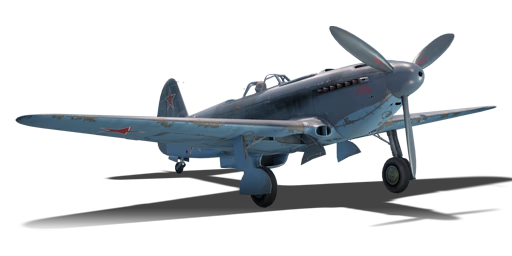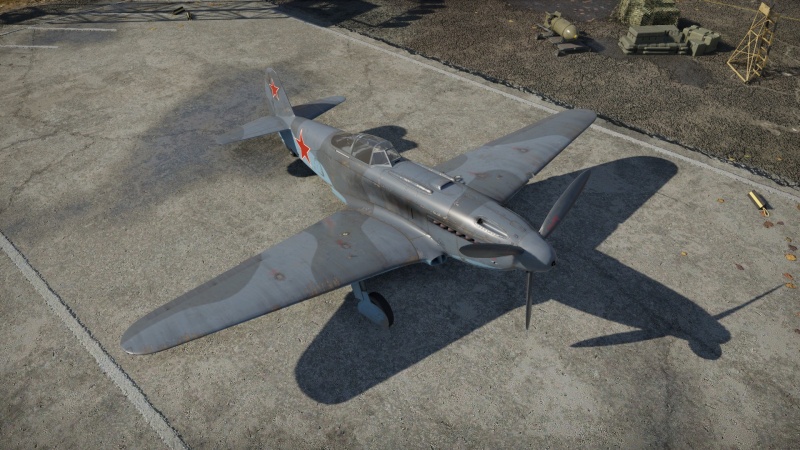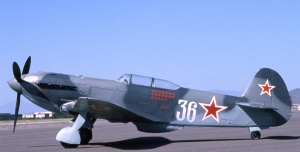Difference between revisions of "Yak-9U"
(→Usage in battles: Corrected VK-107 to M-107 for 9U) (Tag: Visual edit) |
(→Historical design and development: Corrected VK-107 to M-107 for 9U) (Tag: Visual edit) |
||
| Line 157: | Line 157: | ||
[[File:Yakolev Yak-9U Frank.jpg|thumb|Yakovlev Yak-9U Frank]] | [[File:Yakolev Yak-9U Frank.jpg|thumb|Yakovlev Yak-9U Frank]] | ||
| − | January to April 1944 marked the commencement of State trials and revealed that the Yak-9U had a superior top-speed compared to all fighters in service on the Eastern front at 6,000 m (19,685 ft). Unlike the [[I-185 (M-71)|I-185]] the Yak-9U was a much simpler to fly and stable aircraft. | + | January to April 1944 marked the commencement of State trials and revealed that the Yak-9U had a superior top-speed compared to all fighters in service on the Eastern front at 6,000 m (19,685 ft). Unlike the [[I-185 (M-71)|I-185]] the Yak-9U was a much simpler to fly and stable aircraft. Unfortunately the M-107A engine inherited all the problems of the VK-105PF engine. The engine was prone to overheating, oil leaks, loss of engine pressure during climbs, spark plugs constantly burning out, and intense vibrations which would fatigue assembly bolts leading to a short engine life. These defects forced the first production batches starting during April 1944 to be powered by the reliable M-105 PF-3 engine. Further changes would include the fuel capacity of the Yak-9U being upgraded to 400 L (106 US gal) and in order to re-balance the aircraft, the wings where moved 9.906 cm (3.9 in) forward and the aircraft's VlSh-107LO propeller being replaced with the older VISH-105S. A total production of 1,134 aircraft where constructed by December 1944. |
The model in-game does not sport the production batch's modifications as it is the prototype trial model. | The model in-game does not sport the production batch's modifications as it is the prototype trial model. | ||
Revision as of 06:27, 19 October 2024
| This page is about the Soviet fighter Yak-9U. For other versions, see Yak-9 (Family). |
Contents
Description
The Yakovlev Yak-9U was the sixth variant of the Yak-9 fighter aircraft family. The aircraft was based on the Yak-9T and included significant aerodynamic and structural upgrades similar to the Yak-3. The Yak-9U was powered by the new Klimov M-107A engine, which produced 1,650 horsepower. The burst mass was 2.72 kg/s. During early test flights in 1943, the only comparable Soviet fighter was the Polikarpov I-185 prototype, but it was more difficult to fly and less agile due to its heavier weight. Except for the P-51B Mustang, which could achieve 710 km/h, the Yak-9U's peak speed of 700 km/h at 5,600 m was quicker than any other production fighter aircraft in the world at the time. Overheating issues during the test flight stage were resolved by expanding the radiators during production. It was the best high-altitude Soviet fighter of its time. The Yak-9U flew 398 sorties for a total of 299 hours. A total of 26 battles were fought, with the majority of them ending in victory.
Introduced in Update 1.37, the Yak-9U is one of the few Yak fighter planes that excels at operating at high altitudes. Unlike previous Yak-9s that were powered by the Klimov VK-105PF engine, the Yak-9U is powered by the Klimov M-107A engine. As a result, the Yak-9U is among the quickest planes at sea level in its class. Overall, the Yak-9U combines impressive speed, acceleration, climb, and manoeuvrability but comes with a rather mediocre weaponry for its BR. The Yak-9U's engine improvement lets it maintain good performance up to 5,000 m, allowing players to engage in combat with other high-altitude enemy aircraft without being significantly disadvantaged.
General info
Flight performance
The Yak-9U is an up-engined Yak-9 equipped with the M-107A engine. It sports competitive speed, far above average turning and roll abilities, good acceleration, a high dive limit (by USSR standards), and keeps nice and crisp controls from speeds as low as 250 km/h to 750 km/h. It is arguably the most underestimated vehicle rank-for-rank in the game and is often skipped by players who view it as just another Yak-9.
Unlike previous Yak-9s equipped with the VK-105PF engine, the Yak-9U gets a significant upgrade in the form of its M-107A engine (which also happens to be the engine utilized by the premium Yak-3 (VK-107) and the later Yak-9P/UT). As such, the Yak-9U is one of the fastest planes at sea level at this BR and retains excellent performance up to ~6 km where it can effectively engage higher-speed American and faster climbing German planes. This, combined with the excellent handling and turn-fighting qualities allow the Yak-9U to effectively dictate any engagement- a pilot can turn-fight Bf 109s and P-47s with ease while having the capability to outrun slower yet more manoeuvrable vehicles such as the Spitfire.
At sea level, the Yak-9U can catch most, if not all, planes at its BR, including P-47 and P-51D. Beware, however, as the Yak airframe isn't particularly durable in a dive and will rip at speeds above 720 km/h IAS. Thankfully, forcing an opponent down low effectively seals their fate as you and your team perform optimally at low altitude.
| Characteristics | Max Speed (km/h at 5,000 m) |
Max altitude (metres) |
Turn time (seconds) |
Rate of climb (metres/second) |
Take-off run (metres) | |||
|---|---|---|---|---|---|---|---|---|
| AB | RB | AB | RB | AB | RB | |||
| Stock | 646 | 631 | 20.1 | 20.7 | 14.9 | 14.9 | 380 | |
| Upgraded | 699 | 677 | 18.6 | 19.1 | 22.9 | 18.8 | ||
Details
| Features | ||||
|---|---|---|---|---|
| Combat flaps | Take-off flaps | Landing flaps | Air brakes | Arrestor gear |
| X | X | ✓ | X | X |
| Limits | ||||||
|---|---|---|---|---|---|---|
| Wings (km/h) | Gear (km/h) | Flaps (km/h) | Max Static G | |||
| Combat | Take-off | Landing | + | - | ||
| 720 | N/A | N/A | 280 | ~12 | ~9 | |
| Optimal velocities (km/h) | |||
|---|---|---|---|
| Ailerons | Rudder | Elevators | Radiator |
| < 400 | < 420 | < 490 | > 450 |
Survivability and armour
- 64 mm Bulletproof glass in cockpit front and rear.
- 8 mm Steel plate behind the pilot.
Modifications and economy
Armaments
Offensive armament
The Yak-9U is armed with:
- 1 x 20 mm ShVAK cannon, nose-mounted (120 rpg)
- 2 x 12.7 mm Berezin UB machine guns, nose-mounted (170 rpg = 340 total)
Usage in battles
The Yak-9U offers incredible speed, acceleration, climb and manoeuvrability with the same complementary firepower. Unlike its VK-105 powered predecessors, which suffered significant power loss above 3,500 m, the M-107 engine of the Yak-9U retains decent performance up to 5,000 m, allowing you to partake in the initial dogfight of a match without being at a massive disadvantage. Once the air battle has gone down to a lower altitude, your engine performance will go from good to incredible. With a sea level top speed of nearly 600 km/h there's not many planes that can catch or outrun you. Your acceleration, climb rate and energy retention are superior to most other aircraft as well. The turn rate, while not top notch, is still better than a good portion of your competition.
However, the Yak-9U is not without its flaws. The engine suffers from overheating at lower altitudes, and WEP should be used sparingly. Usage of Manual Engine Controls will slow down the overheating, but not eliminate it. Engine performance above 5,000 m is lacking compared to aircraft of other nations.The armament, while perfectly adequate against fighters, will struggle against heavier targets, and engaging heavy bombers is not recommended unless you're confident in your ability to get a pilot snipe. Due to a somewhat low wing rip speed, most aircraft will outdive you. The acceleration below 200 km/h IAS is poor compared to most fighters, and stall fighting should be avoided unless you started the fight with an energy advantage.
After takeoff, you should immediately start climbing up to 5,000 m. The optimal climb speed is around 250 km/h IAS. When initially engaged with the enemy, it's best to start off the fight slowly. Avoid losing altitude immediately. Try to employ hit and run tactics and conserve your ammo. Once all of the enemies in the area start dogfighting and losing altitude, it's time to become more aggressive. With the loss of altitude, you can start to capitalize on your excellent low down engine performance. Stick to boom and zoom tactics if possible, but don't be afraid of engaging in dogfights if necessary. If you find yourself in a bad situation, know that you can outrun and outaccelerate just about any plane that you can meet. Use your superior speed to disengage, and then re-engage after you've built up and energy advantage.
The Yak-9U offers no bombs, rockets or any secondary payloads, it is an air supremacy fighter armed only with machine guns and cannons. They must be used to defend your ground forces or naval fleets from enemy bombers and fighter bombers. Stay high, use the boom and zoom tactics to your advantage - do not strafe tanks or ships, the 20 mm cannons only offer 120 rounds which will be needed in any air to air combat engagement.
Manual Engine Control
| MEC elements | ||||||
|---|---|---|---|---|---|---|
| Mixer | Pitch | Radiator | Supercharger | Turbocharger | ||
| Oil | Water | Type | ||||
| Controllable | Controllable Not auto controlled |
Controllable Not auto controlled |
Controllable Auto control available |
Separate | Controllable 2 gears |
Not controllable |
Pros and cons
Pros:
- Excellent cockpit visibility
- Good handling and manoeuvrability at most speeds
- Good energy retention
- Good rate of climb
- Excellent acceleration above 150 km/h IAS
- Performs identically to the Yak-9P and Yak-9UT while being at a lower BR
- Nose-mounted weaponry
Cons:
- Relatively low ammo count
- Weaponry inadequate against sturdy targets
- Overheating is a very real issue, MEC will only delay it
- Lower wing rip speed than most of its peers
- Low thrust below 150 km/h IAS
History
Historical design and development
During December 1943, the creation of a new airframe (Yak-9U) allowed the installation of the M-107A engine, which was more powerful than the previous VK-105PF. The engine mount was brand new and included individual faired exhaust pipes, wings, and fuselage structure that was made of metal while the whole aircraft received a covering of Bakelite skin. The horizontal tail surfaces were slightly reduced in order to afford the aircraft improved pitch control. The oil cooler intake was re-positioned from beneath the nose to the port wing root as well as an enlarged radiator bath being moved further aft under the fuselage. A supercharger intake was centred on the top decking of the engine cowling. The rear antenna cable was moved inside a lengthened rear canopy which featured a more aerodynamically refined shape with a modified fuselage deck contour. The typical armament of the Yak-9U was a 20 mm (79 cal) ShVAK cannon with 120 rounds that was fired through the aircraft's hollow propeller shaft, and two 12.7 mm (50 cal) Berezin UB machine guns with 340 rounds.
January to April 1944 marked the commencement of State trials and revealed that the Yak-9U had a superior top-speed compared to all fighters in service on the Eastern front at 6,000 m (19,685 ft). Unlike the I-185 the Yak-9U was a much simpler to fly and stable aircraft. Unfortunately the M-107A engine inherited all the problems of the VK-105PF engine. The engine was prone to overheating, oil leaks, loss of engine pressure during climbs, spark plugs constantly burning out, and intense vibrations which would fatigue assembly bolts leading to a short engine life. These defects forced the first production batches starting during April 1944 to be powered by the reliable M-105 PF-3 engine. Further changes would include the fuel capacity of the Yak-9U being upgraded to 400 L (106 US gal) and in order to re-balance the aircraft, the wings where moved 9.906 cm (3.9 in) forward and the aircraft's VlSh-107LO propeller being replaced with the older VISH-105S. A total production of 1,134 aircraft where constructed by December 1944.
The model in-game does not sport the production batch's modifications as it is the prototype trial model.
Media
- Skins
- Videos
See also
Links to the articles on the War Thunder Wiki that you think will be useful for the reader, for example:
- reference to the series of the aircraft;
- links to approximate analogues of other nations and research trees.
External links
| A.S. Yakovlev Design Bureau (Яковлев Опытное конструкторское бюро) | |
|---|---|
| Fighters | |
| Yak-1 | Yak-1 · Yak-1B |
| Yak-3 | Yak-3 · Eremin's Yak-3(e) · Yak-3 (VK-107) · Yak-3P · Yak-3T · Yak-3U |
| Yak-7 | Yak-7B |
| Yak-9 | Yak-9 · Yak-9B · Yak-9K · Golovachev's Yak-9M · Yak-9P · Yak-9T · Yak-9U · Yak-9UT |
| Twin-engine fighters | I-29 |
| Jet fighters | |
| Yak-15 | Yak-15P · Yak-15 |
| Yak-17 | Yak-17 |
| Yak-23 | Yak-23 |
| Yak-30 | Yak-30D |
| Yak-141 | Yak-141 |
| Strike aircraft | |
| Yak-2 | Yak-2 KABB |
| Yak-38 | Yak-38 · Yak-38M |
| Bombers | Yak-4 |
| Jet bombers | Yak-28B |
| Foreign use | ▄Yak-3 · Challe's ▄Yak-9T · ◔Yak-9P |
| Captured | ▀Yak-1B |
| USSR fighters | |
|---|---|
| I-15 | I-15 WR · I-15 M-22 · I-15 M-25 · I-15bis · Krasnolutsky's I-15bis |
| I-153 M-62 · Zhukovsky's I-153-M62 · I-153P | |
| I-16 | I-16 type 5 · I-16 type 10 · I-16 type 18 · I-16 type 24 · I-16 type 27 · I-16 type 28 · I-180S |
| I-29 | I-29 |
| I-185 | I-185 (M-71) · I-185 (M-82) |
| I-225 | I-225 |
| ITP | ITP (M-1) |
| MiG-3 | MiG-3-15 · MiG-3-15 (BK) · MiG-3-34 |
| LaGG | I-301 · LaGG-3-4 · LaGG-3-8 · LaGG-3-11 · LaGG-3-23 · LaGG-3-34 · LaGG-3-35 · LaGG-3-66 |
| La | La-5 · La-5F · La-5FN · La-7 · Dolgushin's La-7 · La-7B-20 · La-9 · La-11 |
| Yak-1/7 | Yak-1 · Yak-1B · Yak-7B |
| Yak-3 | Yak-3 · Eremin's Yak-3(e) · Yak-3P · Yak-3T · Yak-3U · Yak-3 (VK-107) |
| Yak-9 | Yak-9 · Yak-9B · Golovachev's Yak-9M · Yak-9T · Yak-9K · Yak-9U · Yak-9UT · Yak-9P |
| Other countries | ▂P-40E-1 · ▂P-47D-27 · ▂Hurricane Mk IIB · ▂Fw 190 D-9 · ▂Spitfire Mk IXc |
| P-39 | ▂P-39K-1 · ▂Pokryshkin's P-39N-0 · ▂P-39Q-15 |
| P-63 | ▂P-63A-5 · ▂P-63A-10 · ▂P-63C-5 |






